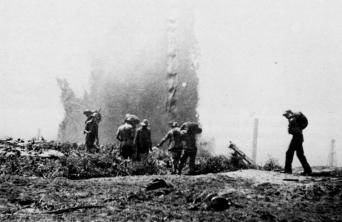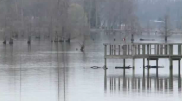Lakeview Gusher: A Brief History
The Lakeview Well erupted on March 15, 1910, releasing a geyser of dark oil that shot into the sky. As days passed, the “Lakeview Gusher” showed little sign of being halted.
According to The Bakersfield Californian, the gusher was still "as strenuous as ever" by its 22nd day. Workers attempted to cover the fountain-like spray with an immense “hood” in the hopes of conserving more oil.
At this point, the gusher had already outlived its predecessors as the greatest one in history.
Months later, on July 22, 1910, Grey River Argus reported the oily geyser had baffled every effort to control it. Between 40,000 to 50,000 barrels of oil were being depleted per day without a hint of slowing down. Much of the oil was lost through absorption into the ground or in spray blown in the wind. According to the article:
"The gusher is almost literally a leak in the biggest pipe ever buried in the underground oil conduit system, and the plumber has not been born that can plug the leak.”
Then, on September 9, 1911, the oil well caved in and sealed itself, putting a stop to the 18-month flow. Over 378 million gallons of crude had been spilled. According to The Bakersfield California, the geyser's demise immediately increased the output at other wells in close proximity.
On Jan 17, 1912, The Gazette Times included a government report that revealed production of petroleum in 1911 increased slightly over the record-breaking figures of 1910.
In July 1926, the Lakeview Gusher appeared in a Union Oil Company of California advertisement within the Spokane Daily Chronicle. The ad compares the oil business to the "eternal human feminine," who has to be wooed and courted with millions of dollars, but is nevertheless necessary to the progress of mankind.
The advertisement continued with a poetic perspective on the disaster:
<blockquote>'Lake View' destroyed her derrick. 600 men, all at one time, had to work like mad to build a 16-acre temporary reservoir; for 'Lake View' -- the beauty! -- seemed to want to bathe the world with oil.</blockquote>
On Feb. 5, 1955, a letter reflecting on the "wildest oil well of all time," appeared in The Modesto Bee. Mrs. M. Girney, author of the letter, recalled a postcard she received from her husband who both drilled the well and was part of the Union Oil Company. The card read: "91st day of producing, 50,000 barrels per day. Lakeview Gusher." Girney said:
"I well can remember when crude oil was selling for 30 cents a barrel and there was not much work in the oil fields because of the overproduction of oil at the Lakeview gusher in California."
Today, the Lakeview Gusher is memorialized with a plaque: California Historical Landmark No. 485. It goes on to describe the disaster as "America's most spectacular gusher.”
Not too long ago, Agnes Hardt, a docent with the West Kern Oil Museum in Taft, took an international group of archaeologists out to the site. But, the times have changed; the site is no longer the tourist attraction is once was. She told the Los Angeles Times:
"I could tell they were disappointed, like, `We drove out here for this?'" she said. "It's more exciting to read about it than it is to see."
Although the BP oil disaster in the Gulf of Mexico was massive, it didn't compare to the Lakeview Gusher, reported ABC News. Even so, Michael Long, publisher of the Taft Independent, commented that these disasters will be a constant struggle for future generations:
"All industries have disasters and we get beyond it and continue to live. Oil is not going to go away. The whole world is powered by oil."






